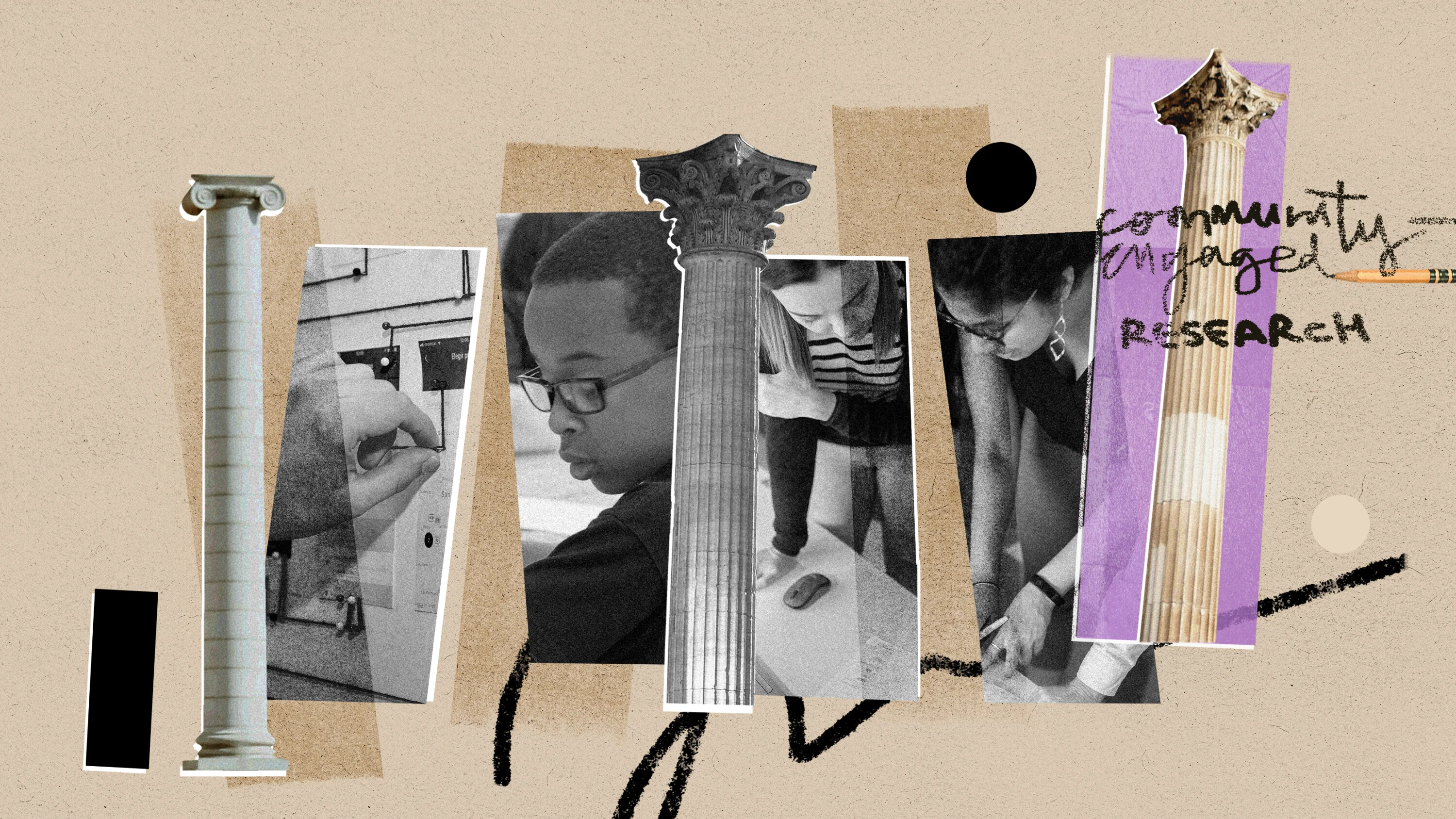The current frame for thinking about racial inequality
The frame that shapes most thinking about how best to correct racial inequality is, unfortunately, incorrect. Emphasizing individual-or group-based deficiencies in behavior and productivity as a root cause of lower incomes and wealth, this frame presumes that upward mobility among those on the low end of the scale is inhibited by “human capital” or “developmental” deficits. As a response, this way of thinking posits various forms of education and training as all-purpose solutions for racial disparities.
The Black–White wealth gap may afford the clearest illustration of what the standard frame gets wrong about racial inequality. For example, the racial wealth gap—in 2016, the average Black household held ten cents to the dollar of wealth held by the average White household—is not a consequence of educational, income, or behavioral differences between Blacks and Whites. Instead, on average, Black households with a head who holds a college degree have two-thirds of the wealth of White households with a head who never finished high school. The poorest White households—those in the lowest quintile of the income distribution—have a median level of wealth similar to the collective median for all Black households. And, after household income is taken into account, there is no evidence of differences in savings rates between Blacks and Whites; indeed, in some income categories, the savings rate for Blacks is modestly higher than the rate for Whites.
Rather than developmental deficits, the fundamental source of Black–White wealth disparity is the uneven transmission of resources across generations. Using data from the Panel Study of Income Dynamics, a 2018 Social Forces article by Pfeffer and Killewald demonstrates the close association between parental and grandparental wealth and the wealth of the younger adult generation. Since older generations of Black Americans generally have considerably fewer resources to transfer to their children, a cumulative and sustained intergenerational process operates to deprive Blacks of wealth. Furthermore, in a Federal Reserve study issued in 2018, Feiveson and Sabelhaus estimate that at least 26% to upwards of 50% of an adults’ wealth position is due to gifts and inheritances. These estimates were generated without accounting for the indirect effects of parental transfers or expected parental transfers on personal security for entrepreneurial risk-taking and reduced personal costs for education. It may be the case that wealth is more a driver of educational attainment, especially higher education, than educational attainment is a driver of wealth accumulation.
Rather than developmental deficits, the fundamental source of Black–White wealth disparity is the uneven transmission of resources across generations.
The standard frame for thinking about responding to racial inequality also grossly underestimates the impact of discrimination on Black earnings and income. Success in overcoming the ostensible developmental deficits does not provide insulation from the penalties exacted by racism. In fact, there is evidence that suggests that as Blacks obtain greater levels of education, the degree of discrimination they face in labor markets actually intensifies. A number of field experiments and correspondence tests have shown that Black applicants with comparable credentials to Whites are less likely to get callbacks for jobs, are less likely to be informed about potential opportunities for promotion within a firm, and are more likely to be offered lowered wages upon entry. At the upper end of the status distribution, a 2016 Bloomberg News investigation conducted by Natalie Kitroeff revealed that Black MBAs with a Harvard Business School degree who began their careers between 2007 and 2009 had starting salaries $5,000 lower than their White peers with the same degree who began at the same time. To compound matters, by 2015 the racial pay gap had skyrocketed to $100,000 among the same set of Harvard Business School graduates.
A third weakness in the current frame that informs policymaking toward reduced racial inequality is disproportionate attention drawn to childhood investments. Not only is there a tendency to ascribe racial disparities to developmental deficits, there is also a tendency to assume that they only can be corrected by targeting the youngest children. To a degree, the conversation about remedies for both general inequality and racial inequality has been hijacked by James Heckman’s message. The consequence is a persistent claim that there is a higher return on investment associated with channeling resources toward the very young and a tendency to exclude from serious consideration proposals that focus on improving the economic and social conditions facing even teens and young adults. A sole emphasis on early childhood education, for instance, can have a triage effect on addressing the low quality of education experienced by many older students—and their potential.
A new frame: A new agenda
An alternative frame for confronting racial inequality in the United States would emphasize linked deficiencies in resources and options rather than deficiencies in human capital. The focus needs to move toward an emphasis on the structural barriers that maintain uninterrupted racial inequality rather than Black shortcomings. The problem is not Black ability; it is Black capability.
An alternative frame for confronting racial inequality in the United States would emphasize linked deficiencies in resources and options rather than deficiencies in human capital.
I use this alternative frame to propose a new agenda for eliminating racial inequality—one that increases resources for Black Americans rather than “improves” Black Americans; recognizes the persistent and devastating role of discrimination; includes the needs of young Black people beyond early childhood; and treats Black access to quality education as an intrinsic good rather than primarily an instrument for higher income. Importantly, research is needed to build, test, and increase understanding of ways to design this agenda in policy and practice, and to challenge the stubborn assumptions and approaches put forth by conventional modes of thinking.
Redistributive Programs
The most direct policy to eliminate racial wealth inequality would be a program of reparations for Black Americans. Research funders could make a valuable contribution to the development of such an effort by supporting work that examines how Black lives are altered by the receipt of resources comparable to those received by White households, and/or by supporting research efforts aimed toward the precise design of an effective reparations program. The general principle is that the racial wealth gap is best removed by direct redistributive measures, rather than ineffective indirect measures like increasing Black educational attainment.
A universal redistributive program could replicate, partially, some of the benefits for addressing racial wealth inequality from a fully implemented reparations program. In my own work, I have been engaged with collaborators in the development of what now is popularly referred to as the “baby bonds” plan. The plan does not propose a bond but a publicly held trust account for each newborn infant that they can access when they enter young adulthood. It would be an asset-in-waiting that may be used for further asset building, i.e., buying a home, starting a business, attending college, retiring existing educational loans, or some other purpose that improves economic well-being. It is not a race-specific program, but, de facto, can be a race-conscious initiative insofar as it would disproportionately benefit segments of the American population with the least wealth.
Key issues that would demand investigation are the sheer amount of the endowments; the basis for calibration of the sum that goes to each young person, i.e., a uniform amount or an amount adjusted for the income and/or wealth position of their family; the age at which funds are received; the composition and management of the endowment (should they take the form of a sheer cash outlay, equity shares, savings accounts, mutual funds, or a diversified mix of assets?); and the extent of restrictions, if any, that would be placed on the use of the trust account. Large-scale experimental research exploring the effects of such a provision would facilitate refinement and suitable design of the program, while a smaller scale research alternative would be qualitative experiments with a much smaller number of participants. In either case, research to inform the development of the intervention would be critical.
K–12 Education Policy
The focus on educational access for Blacks at the K–12 level has been on school desegregation, under the presumption that Black and White students attending the same schools will receive the same quality of education. But, in fact, curriculum and instruction is racially stratified as a consequence of racialized tracking within desegregated schools. The fundamental question for researchers, then, is how do we insure that all students (Black students in particular) receive a high-level, challenging program of study coupled with excellent teaching, regardless of their school’s overall racial demographics? How do we facilitate the transition from mediocre classes to challenging classes for high school students who have been confined to lower track classes? Could this be accomplished if the equivalent of gifted education was provided to all students? Is it possible to detrack toward excellence for all?
Researchers could identify and evaluate efforts to universalize gifted education or its equivalent, assess the outcomes, and determine how to most effectively replicate successes. Specific cases for intensive study might include the development and implementation of Project Bright Idea, subsequent to a 2004 Javits grant in North Carolina, and the experience with de-tracking at Rockville Centre High School on Long Island while Carol Burris, who is now the Executive Director of the Network for Public Education Foundation, was principal in the early 2000s.
Higher Education Policy
The demise of affirmative action will necessitate the construction of creative alternative routes for maintaining racial inclusion at selective institutions. Research funders can support the development, design, and implementation of these alternatives. One potential option would be for selective institutions to set a (reasonable) minimum set of standards that must be met by all applicants in terms of measurable criteria, then constructing classes by randomly selecting students from among those who meet the threshold. The capacity to produce a student body that is representative of the nation’s population would depend upon recruitment of a representative applicant pool. Regardless, institutions must adopt different strategies to build greater racial inclusion, and research can help us understand which approaches can be most effective, for whom, and under what conditions.
The demise of affirmative action will necessitate the construction of creative alternative routes for maintaining racial inclusion at selective institutions. Research funders can support the development, design, and implementation of these alternatives.
At the same time, the cost of higher education is a barrier to entry for many potential students. While my instincts tell me that free tuition at public universities is a good idea, we lack adequate research evidence to assess the potential outcomes of such a policy. Centering on future tuition expenses also leaves open the question of how best to address the overhang of debt burden held by those who have attended college and university by taking substantial loans. Again, new research may inspire and inform creative efforts to tackle the costs of higher education on both dimensions.
Conclusion
A genuine confrontation with racial inequality will require a new way of thinking that challenges the structural roots of racial disadvantage and the consequences of generations of anti-Black discriminatory policies. A new agenda for transformative change emerges from altering the frame we use for understanding racial disparities. The alternative frame stresses resource deprivation and the cumulative effects of discrimination as fundamental causes of racial inequality; the alternative frame also stresses the importance of paying deep attention to the need to support teens and young adults rather than exclusively devoting consideration to infants and toddlers. Researchers should develop the evidence base to build, test, and illuminate policies that execute a racial redistribution of wealth—whether via race-specific or by universal but race-conscious measures – as well as policies that provide gifted caliber education for all primary and secondary school students; that craft racially inclusive measures that will substitute for affirmative action in higher education; and that insure that cost is not an obstacle to access to higher education.















